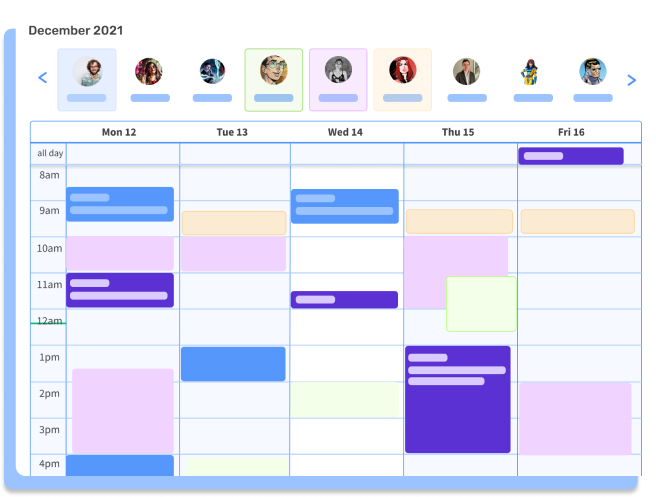During the pandemic, organizations all around the globe realized the benefits of remote work – whether it be increased levels of productivity, real estate cost savings, or automated, efficient processes.
According to research by Gartner, some exceedingly interesting numbers about remote work have emerged.
Around 31% of the global workforce will be a combination of remote and hybrid by 2022 and about 53% of the US workforce will be working remotely.
With that said, managing a remote workforce isn’t a morning stroll in the park. It’s critical to provide the right tools and implement the best practices to ensure that the workforce performs optimally.
In this blog post, we’ll cover the most important practices to help you manage your remote team effectively.
- Encourage Check-ins
- Leverage Technological Tools
- Lay Down The Ground Rules
- Align the Team With Your Expectations
- Monitor Results, Not Activity
- Involve Everyone by Defining Purpose
- Be Flexible, and Equip Your Employees Well
- Remove Obstacles, be Understanding
- Steer Away from Work Sometimes
- Mentorship Works Better Than Management
- Closing Note
Encourage Check-ins
Since team managers can no longer see when employees arrive at work, it is a good idea to schedule daily check-ins. This way team leaders and management can see who “attended” work.
Decide on a time and arrange brief video conferences every morning to delegate daily work and tasks. If required, a check-out meeting could also be scheduled to get an overview of the progress.
Leverage Technological Tools
Technology has been a critical tool for both employers and employees during the pandemic.
Video conferencing platforms, for example, enable team managers to run effective online meetings and easily monitor the on-job progress. Furthermore, one-on-ones, daily standups, or team buildings can be planned and scheduled on the fly.

Similarly, depending on your business needs, you should also consider using project management, time tracking, or inventory management software to make your remote workforce’s day-to-day job easier.
Lay Down The Ground Rules
Juggling instant messaging, conferencing apps, scheduling, and project management tools, may cause confusion.
To avoid this, lay out some ground rules regarding the purpose of each communication channel clearly. For example, use IMs for quick interactions, questions, and clarifications.
However, by far the best way to effectively manage remote employees is to organize all your collaboration and communication channels together under the same digital roof.
Align the Team With Your Expectations
It was simple during normal workdays to elaborate your objectives and goals to the team and get them oriented towards working accordingly.
With a remote-first team, though, this can be a challenge.
Try to establish a culture of open communication.
Seek feedback and convey your expectations from the team and each individual separately. Ensure that the team stays motivated and comprehends what needs to be achieved.
Monitor Results, Not Activity
Working together in offices gave team managers the benefit of supervising their team’s tasks and keeping an eye on the wasted time.
However, sometimes, when managing remote employees, it is not that easy.
You certainly don’t want to come out as being overly controlling of your team members while they work in their own homes.
It is better to focus on deriving results from your team rather than choreographing their activities.
Hold your team accountable and responsible enough to achieve the results you expect.
Involve Everyone by Defining Purpose
The best way to bring your team wholly onboard on a task is to define why it needs to be achieved.
This gives them a reason to stay motivated and committed throughout the project.
To do so, write down your goals and collaborate with your team on a plan that includes all the steps needed to achieve these goals.
Define tasks and assign responsibilities to all team members and make sure everyone can see how their daily tasks are linked to the overall project goals.
Be Flexible, and Equip Your Employees Well
Remote work isn’t always straightforward. While most employees can afford laptops and gadgets required for remote work, some cannot.
Ensure that your organization provides all employees with the requisite resources that enable them to work remotely. For example, reliable WiFi connection, laptops, headphones, etc.

Additionally, give your employees the flexibility to choose how they want to work – remotely, hybrid, or on-site.
Remove Obstacles, be Understanding
There are ample distractions that potentially keep the team away from the desk when working remotely.
Children being schooled from home, pet responsibilities, household chores, etc.
All that, combined with work pressure, creates a stressful environment that impacts well-being and productivity.
Ensure that the remote work culture and ground rules you lay down for your team take these aspects into consideration.
Steer Away from Work Sometimes
Sometimes, you just need to blow off some steam.
Upon completion of a project or an important milestone, it helps to carve out some time to have unofficial, social interactions.
If your team members seem eager, take the opportunity to suggest an at-home wine and dine for an hour or so, or a beer and pizza night.
Mentorship Works Better Than Management
The past two years have been hard, full of anxiety, stress, uncertainty, and directionless efforts.
Managers need to up their game and empathize with their team on these issues.

Taking a gentler, mentoring approach towards guiding your team works better than ordering them around and plastering goals and deadlines all over their screens.
Help them out – whether on a personal or professional level – because remote work can be as challenging for the employees as for the organization.
Closing Note
As the number of people who want to work remotely continues to grow, more and more companies are offering remote positions.
Virtual teams help business owners save money and increase productivity but managing remote employees comes with its own set of hurdles. Luckily, there are tools and best practices for you to follow in order to make this task much easier
Make sure that you build an online workspace that is conducive to success and that both managers and employees are proactive in their approach. The results will be worth the effort.
Now that you know the best way to manage remote employees, it’s time to get started!

Ashwini Dave
Ashwini is a free soul and adventurous scholar who enjoys spending time with her loved ones as well as listening to music and playing sports. She loves the ocean and is a thrill-seeking traveler who looks at life as a work of art.



